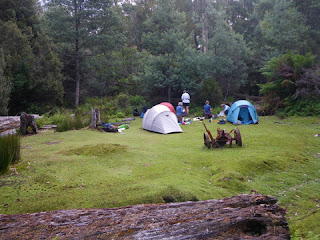The walk to Lake Rhona is a long day walk from the Florentine State forest or as we decided for this trip we would take 2 days to reach the Lake, camping the first night at the historic settlement of Gordonvale.
Gordonvale was the home of Ernie Bond who farmed this area from the middle 1930's to the late 1950's. Very little is left of the settlement,a rusty plow,saw,rhododendron bushes,a walnut tree , rubbish piles hidden in the scrub and the peak of what was the roof of his house.
 |
| Walking up the Rasselas valley |
I had heard that there were still some of his raspberry plants growing hidden in the scrub but after an
exhaustive search was unable to find them,presumably they died out years ago.
 |
| Anne can see where we need to go. |
The second day we were up bright and early for the 4 to 5 hours it would take to get to Lake Rhona.
The Vale of Rasselas was very and was as dry as I had seen it 17 years ago when I last did this walk.
We arrived at the foot of the Denison Ranges on a quite warm day for the long walk up the ridge to the lake.
 |
| Nat relaxing on the way up to Lake Rhona |
After the long climb we were rewarded with a beautiful view of the spectacular Lake Rhona and Reed's Peak.
 |
First view of Lake Rhona and Reed's Peak
Next morning we awoke to a bright and sunny morning so we all headed down to the beach for breakfast. |
 |
| Nat having breakfast on the beautiful beach at Lake Rhona |
We set up camp right behind the beach for 3 nights at beautiful Lake Rhona,the next day we climbed up onto the Denison Ranges and climbed Reeds Peak and did the circuit back to Lake Rhona.
 |
View south west from the Denison Range
We arrived back just at the sun was setting over Reeds Peak. |
 |
Evening light at Lake Rhona
The next day we explored around Lake Rhona taking lots of photographs. |
 |
| Eucryphia milligani flowering above the lake |
Eucryphia milligani a subalpine version of the rainforest species (Eucryphia lucida) was flowering in profusion behind our campsite and it gave the area a beautiful sweet scent.
 |
| Leaving Lake Rhona |
After 3 lovely days at Lake Rhona we left on a wet and miserable morning with wonderful memories of a special place.

























